
Prunella is a genus of herbaceous plants in the family Lamiaceae, also known as self-heals, heal-all, or allheal for their use in herbal medicine.

Gongylus gongylodes, also known as the wandering violin mantis, ornate mantis, or Indian rose mantis, is a species of praying mantis in the family Empusidae. Characterized by extremely slender limbs with large appendages, it is not a particularly aggressive species and often kept as a pet. The mantis is especially known for swaying its body back and forth to imitate a stick flowing in the wind. It primarily feeds on flying insects. Its native range is in southern India and Sri Lanka. It can reach up to 11 cm (4.3 in) long. The males of the species are capable of flight. They are a communal species, in that they are able to live and breed in large groups, without unnecessary cannibalism. Adult females are about 10cm and adult males are about 9 cm.

Archimantis latistyla, commonly known as the large brown mantis is a species of mantid native to Australia. The large brown mantis has two subspecies, a widespread subspecies and the stick mantis ghost from Bundabergs Turtle Sands. The stick mantis ghosts are not as aggressive as the widespread species but have a defense display used to make the mantis appear larger by flinging its front legs into the air and putting its head down along with its antennae. Large brown mantids are light brown with short winged female and a long winged male. The subspecies from Bundaberg is a pale cream white with a yellow and black eye in between the arms. The large brown mantis female is short winged - her wings reach only half her abdomen and she is not able to fly— but the long winged male has wings that cover the entire abdomen. They have two pairs of wings - the top pair are the wing covers and the bottom wings enable the mantis to fly.

Brunneria borealis, common name Brunner's mantis, Brunner's stick mantis, or northern grass mantis, is a species of praying mantis native to the southern United States. It is the only mantis species known to reproduce solely through parthenogenesis; there are no males.

Popa spurca, also known as the African twig mantis, is a species of mantis native to Africa. It takes its common name from its resemblance to twig from a woody plant and grows up to 8 centimetres (3.1 in) long if female or 7 cm (2.8 in) long if male.

Brunneria is a genus of praying mantises in family Mantidae. They are often called stick mantis for their slender shape and the species of the genus are native to the Americas.

Iris is a genus of praying mantis found in Africa, Asia, and Southern Europe with one species, Iris oratoria, being introduced to North America in the south-western United States.
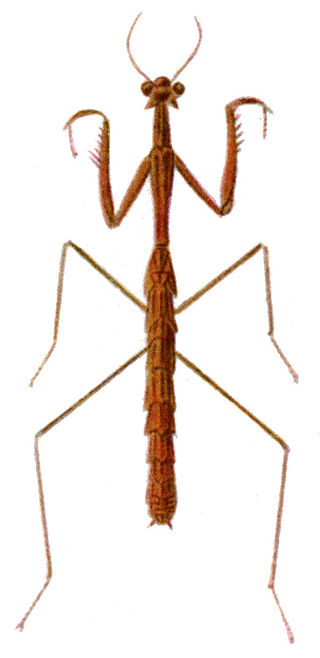
Stick mantis and twig mantis are common names applied to numerous species of mantis that mimic sticks or twigs as camouflage. Often the name serves to identify entire genera such as is the case with:
Grass mantis is a common name mostly given to various species of praying mantis that mimic grass or other slender vegetation. Species to which this name has been applied include but are not limited to:
Bolbena is a genus of praying mantises native to Africa. It includes the following species:
Gyromantis occidentalis, commonly known as the eastern bark mantis, is a species of mantis found in Australia.
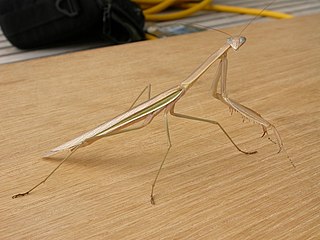
Tenodera australasiae, the purple-winged mantis, is species of praying mantis. Found throughout Australia, it is common in the eastern regions. Both males and females are capable of flight. The species has not been shown to be parthenogenetic.
Daniel Otte is a South African-American ecologist, entomologist, world expert on crickets and grasshoppers and prominent scientific illustrator. He has made significant contributions to evolutionary biology. He is curator and chairman of the Department of Entomology at the Academy of Natural Sciences in Philadelphia.
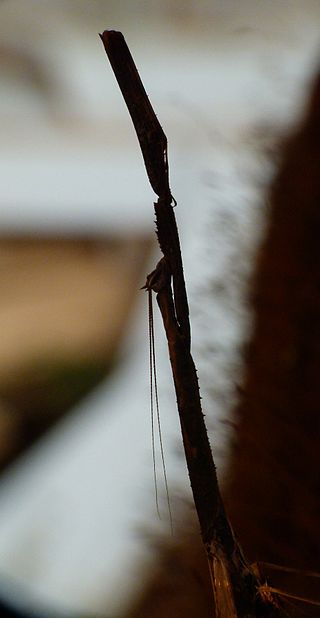
Toxoderidae is a family of praying mantises.

Mantises are an order (Mantodea) of insects that contains over 2,400 species in about 460 genera in 33 families. The largest family is the Mantidae ("mantids"). Mantises are distributed worldwide in temperate and tropical habitats. They have triangular heads with bulging eyes supported on flexible necks. Their elongated bodies may or may not have wings, but all Mantodea have forelegs that are greatly enlarged and adapted for catching and gripping prey; their upright posture, while remaining stationary with forearms folded, has led to the common name praying mantis.
B. orientalis may refer to:
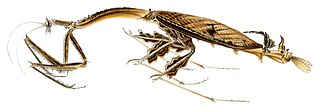
Toxodera is the type genus of mantises in the family Toxoderidae, known for their stick mimicry. There are four confirmed species in Borneo restricted to old-growth forests, and are considered to be rare. Species of the South-East Asian Toxoderini inhabit beneath the forest canopy. Not much is known regarding their ecology. Males however, are often attracted to lights. One species, Toxodera maxima, can reach 18 cm in total length.
Iris orientalis is a species of praying mantis found in Asia.
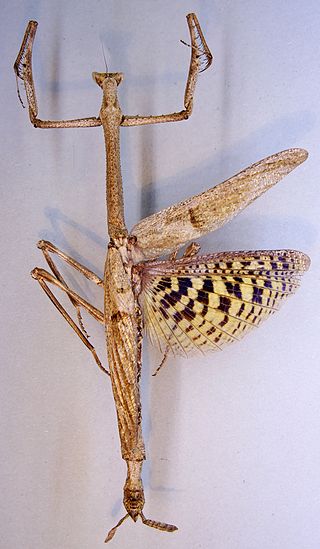
Heterochaeta is a genus of mantis native to Africa.












